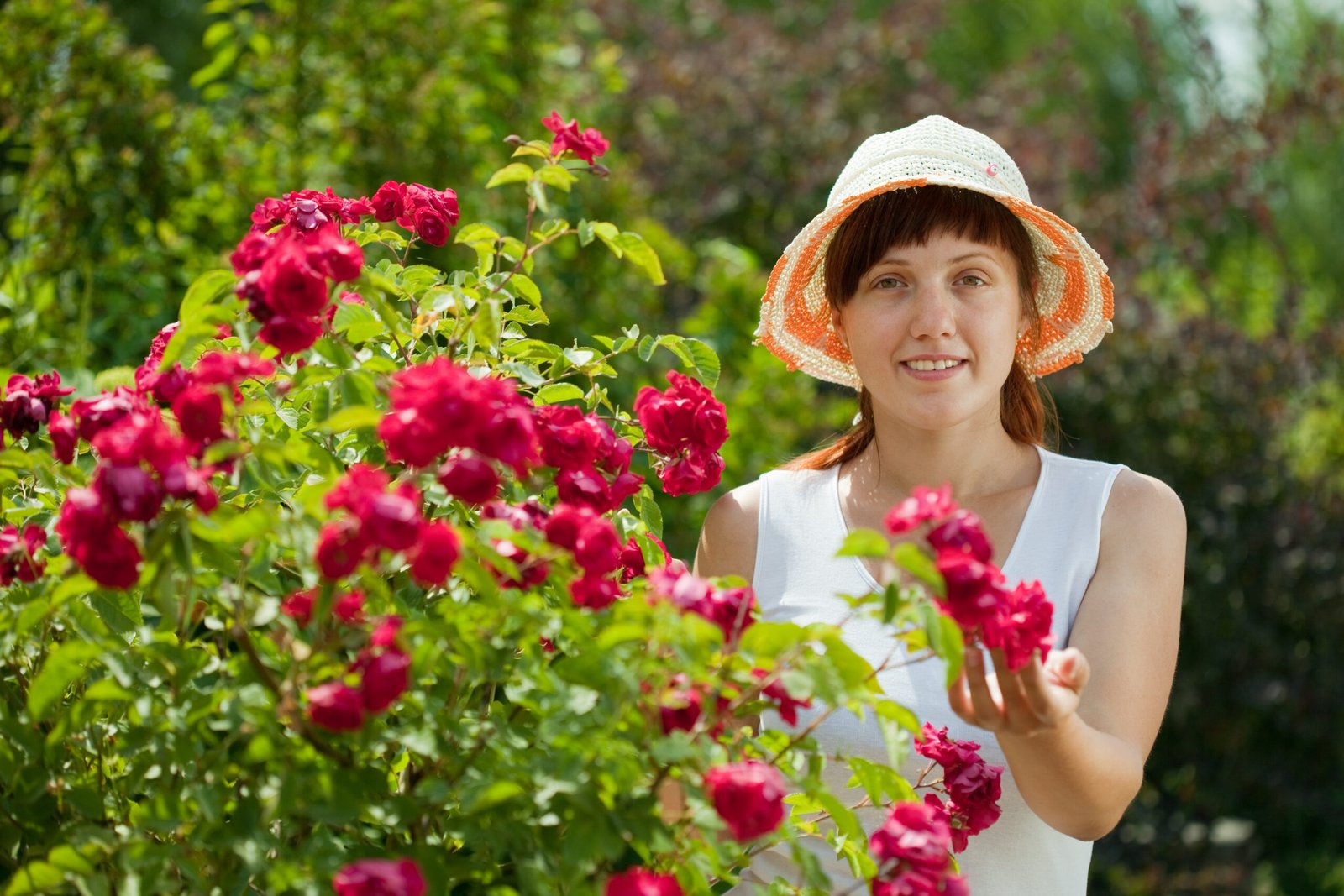how to prune roses New gardeners can produce stunning results with roses by following basic pruning principles. Pruning should not scare you; the guidelines and warnings are primarily for those who grow roses for show. For amateurs, however, just a few simple rules are all that’s needed to have beautiful, healthy rose bushes.
When To Prune Roses
Roses are best pruned in late winter to early spring when new growth appears. This can be as early as January or as late May, depending on your location.
Regional Estimates for if you want to mark your calendar or set yourself a pruning reminder:
Zones 3 and 4 – May
Zones 5, 6, and 7 – March or April
8 – February or March
9 – January or February
Zone 10 – January

Spring:
Major pruning should be done in early Spring after the last frost in cold climates, following the eight simple steps below. Alternatively, roses may tell you that when they begin budding or leafing out, it is time.
Summer:
In the summertime, dead flowers can be removed. According to Carl Bennett, the Rose Breeding Manager at David Austin Roses, deadheading will help produce more blossoms and retain an attractive bush during the flowering season.
Fall:
Cut down long stems after the first cold snap to avoid breaking them in winter storms. Also, to stop them from being uprooted by strong winds, make sure that rose bushes are not top-heavy. Additionally, crossing branches that can rub against each other and get damaged should also be reduced. However, please do not over do it, as too much cutting can encourage new growth, which freezing temperatures may destroy. Ensure you remove any dead or diseased branches or leaves and wash your pruning tools well to prevent the spread of infections to other plants.
How to Prune Roses, Step by Step
Just how much you want to prune your roses is up to you; therefore, in order of priority, follow this step-by-step guide to determine what should be removed. All final cuts must be made at a 45-degree angle above an outward-facing bud eye, as shown in the image above. You should know that, by and large, roses are vigorous plants that are very hardy and can hardly be damaged beyond irreparable repair during pruning. In most cases, any mistakes you make will soon be hidden by new growth.
Remove Dead Parts
Remove any branches or canes that have died. Cut back to living tissue, which appears green on the outside.
Prune Broken Or Unhealthy Branches
Trim diseased or injured branches until only healthy wood remains.
Remove Crossed Branches
Prune away branches crossing through the center of the plant. Trim them at their point of origin from a central stem as it helps open up the middle of the plant.
Clear Weak Growth
Take out any very thin or weak growth compared with others around it; this will help concentrate nutrients in stronger stems.
Remove Suckers
For grafted roses, cut away any suckers that emerge from the roots. This growth will not have the same traits as the plant above the graft union.
Remove Old Growth
If this would overly thin out the plant, get rid of older woody growth. This will make the rose produce young, vigorous flowering stems instead.
Eliminate Old Growth
If there are still some branches rubbing against others, remove those smaller ones. Otherwise, this rubbing wound may be an entry point for diseases.
Prevent Rubbing Branches
Trim to change how tall and wide your rose is overall. If you want it in a rounded dome shape at the top rather than flat across, then blooms should flower all over its height.
Clean Up Pruning Debris
When you’re done pruning your rose bush, it’s time for perhaps its most difficult part: cleaning up after yourself. One can use a large makeshift dustpan like a cardboard box to help scoop clippings into by using a rake to collect them all together in one place.

Pruning An Unknown Rose
If you inherited a rose or lost its label, you may not know what type it is. If so, our basic guidelines below will help you get started. Prune in February or March.
Climber Or Rambling Type
Then it is a climber or rambler if your Rose has long arching stems, is very tall, or needs something to support it.
- Go easy with where there is only one thick old stem going down to ground level, as it may not regenerate if cut hard back; instead, shorten it by between 1/3 and 1/2
- For multi-stemmed roses, aim to take out one or two of the oldest-looking stems (i.e., grey, flaky bark) as near to the base as you can
- It’s a rambler if, next season, the Rose sends out lots of very strong but barren (non-flowering) shoots. A climber that responds with less vigorous growth, which ultimately bursts into flowers.
Shrub Or Bush Type
Small roses are easy to identify, so look at our patio and miniature rose guide. Big roses can be any type, When one particular cultivar is cross-pollinated with another different cultivar, the resulting offspring is called a hybrid plant. Generally, hybrids have better genes than non-hybrids since they result from mating between plants of different breeds rather than those of the same breed or variety. Hybrid Tea and Floribunda can be turned into species and shrub roses if in doubt:
- One or two stems should be removed at the ground level or lower down greener-looking (green-barked) side stems.
- The remaining stems should be shortened by 1/3rd to a half
- It will likely be floribunda or hybrid tea if it grows back with vigor next season and has many flowers.
- Otherwise, this may indicate that it is one of the many types of shrub roses.
Rose Fertilizer In Spring
All pruned roses will benefit from a general-purpose rose fertilizer in spring.
- Mulch is a layer of material put on top of the soil surface between November and February.
- It serves several purposes, such as protection against frost, adding nutrients for plant growth or increased organic matter content in the soil, thus reducing water evaporation levels, decorating the garden, and preventing weeds.
- Some examples are composted garden waste, manure such as lawn dressing, wood chips for playgrounds, gravel grits, slate chippings, etc.
Mulch With Garden
Garden compost is a term for homemade garden compost or seed/compost. Organic matter is derived from decomposed plant materials, often confined to a heap or bin added to the soil to improve its nutrient status, structure, and moisture-holding capacity. Seed or potting composts, on the other hand, are specially intended for growing young plants in pots: you can find many commercially available peat-free mixes that consist of different components, including loam, well-rotted bark, coir, and sand, but you may prefer to mix your own.
Hate Pruning, But Love Roses?
- You do not have to give up on growing roses if the above mentioned steps are too challenging. Plant landscape roses, and there will be many colors in your yard, unlike hybrid teas, which require great attention to detail even when pruning.
- Pruning landscape roses is straightforward; cut out any old or dead wood coming into spring and take away about half of the plant’s height.
- If you want to avoid heavy pruning or constant deadheading, try the Oso Easy® series. Here, they resist most diseases; thus, no spraying is required.
Tips for Beginners on Pruning Roses
- Though becoming a consummate pruner of roses may take practice and time, do not be discouraged; the experts in gardening hold that killing a rose bush is quite difficult, and most errors will grow quickly.
- The best time to prune roses is early spring before blooms form.
- Prune roses at an angle of 45 degrees above an eye bud while angling downwards on the alternate side of the stem from where the bud lies.
Quick Tip: Start by removing dead, damaged, or diseased branches. Cut at a 45° angle just above an outward-facing bud for better air circulation and healthier growth.

FAQs
How do you prune roses for beginners?
Cut dead, damaged, or weak branches. Trim above outward-facing buds to shape the plant and improve air circulation.
When should roses be cut back and how much?
Prune in late winter or early spring. Cut back about 1/3 of the plant for most types of roses.
Is there a wrong way to prune roses?
Yes, avoid cutting too close to buds or leaving long stubs. Always use clean, sharp tools.
How to trim roses to keep them blooming?
Deadhead blooms regularly and trim lightly to encourage new growth and flowers.

